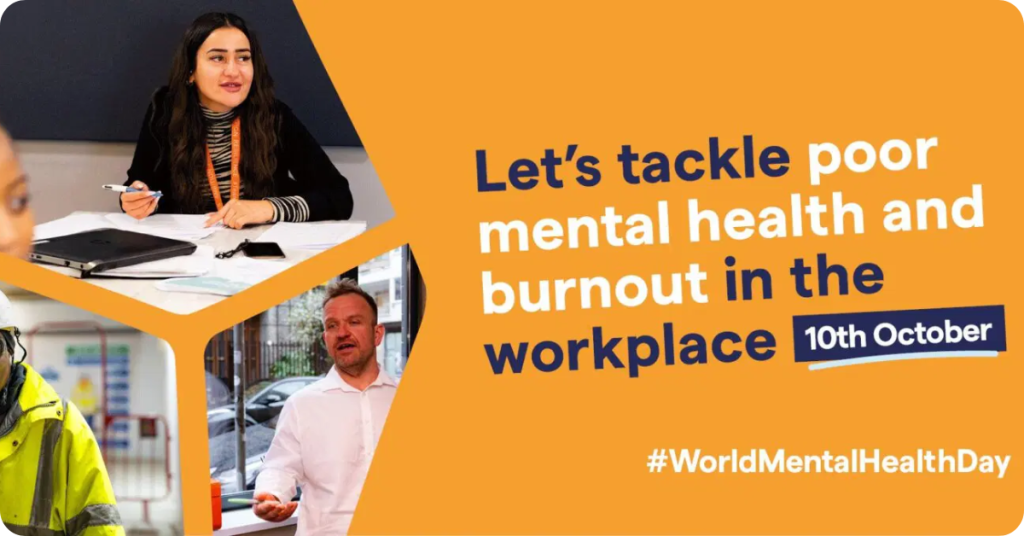Burnout at work: Why acting now matters
-
 Anastassia Murašina
Anastassia Murašina

On October 10th, 2024, we celebrate World Mental Health Day, with the theme “It’s Time to Make Mental Health at Work a Priority.” As part of this, we’ve decided to talk about a significant and increasingly common issue – burnout.
Burnout is a condition caused by chronic stress, affecting both mental and physical health. A person may feel exhausted, lose motivation and interest in work, experience constant fatigue, and feel unable to perform tasks as well as they used to. Long-term stress and burnout can
also lead to serious health problems, including anxiety, depression, and sleep disorders.
Kristiina’s story: Burnout symptoms and causes
Let’s take Kristiina (name changed) as an example, who worked as a project manager at a large international organization. Initially, Kristiina was very enthusiastic about her work, dedicated, and always willing to take on extra responsibilities. She managed several projects
at once, and her colleagues praised her for her work ethic and dedication. However, over
time, Kristiina began to feel constantly tired, her tasks seemed overwhelming, and she no longer found joy in activities she once loved.
Kristiina started making mistakes at work but blamed herself and tried to work even harder to
compensate. She found it increasingly difficult to go to work each day, her relationships with colleagues became strained, and even at home, she couldn’t stop thinking about work.
Despite her efforts, she constantly felt she couldn’t meet her employer’s expectations.
Kristiina’s story is, unfortunately, familiar to many. Her burnout was caused by chronic stress from overwork, workload pressure, a lack of work-life balance, and the constant need to meet
expectations. Kristiina didn’t know when to stop and give herself a break, which ultimately led to mental and physical exhaustion.
A psychologist’s recommendations for preventing burnout
Siffi’s psychologist recommends several steps for Kristiina and others in similar situations to
prevent burnout:
- Set priorities and delegate tasks: You don’t have to do everything yourself—focus on the important things and let others take on tasks to achieve better collective results
- Take breaks and rest: Regular breaks during the workday and maintaining a balance between work and rest are key to preventing burnout.
- Stand up for your boundaries: Maintain a healthy balance between work and personal life, avoiding excessive overtime and not bringing work home.
- Find support: Talk to your supervisors or colleagues if you feel overwhelmed by your workload. If necessary, seek professional mental health support.
What can leaders do to support employees and prevent burnout?
Burnout prevention is not just the responsibility of the employee. Leaders and organizations
play a crucial role in ensuring the well-being of their employees.
Here are some recommendations for leaders to help prevent burnout in their teams:
- Create an open and supportive work environment: Employees should feel that they can talk openly about their problems and needs without fear of being judged.
- Monitor workloads and offer flexibility: Workloads must be realistic, and employers should provide flexibility to help employees balance work and personal life.
- Provide mental health support: Regular mental health training and support programs for employees can help prevent burnout. It’s also important to ensure that these programs are effective, accessible, and easy for employees to seek help anonymously.
- Recognize and value employees: A lack of recognition and constant pressure are common causes of burnout. Leaders must regularly provide positive feedback and recognition for employees’ work.
How Tiina, a successful team leader, prevented burnout in her team
Tiina is a team leader at a mid-sized tech company, where competition is fierce and deadlines
are tight. The workload is very heavy, and in the past six months, stress levels have increased
significantly in Tiina’s team. Many of her colleagues have started to show signs of burnout –
fatigue, constant frustration, and a decline in motivation.
But Tiina managed to prevent this trend in her team. How?
Tiina started with open communication. Every week, she held short meetings with her team,
where everyone could openly discuss their workload, concerns, and suggestions. Instead of
just listening, Tiina offered concrete support, whether it was reorganizing the workload or finding additional resources. The whole team felt that they had the freedom to speak up without fear of judgment.
Tiina monitored the workload of team members and took into account each person’s capacity and current situation. If an employee felt overwhelmed, Tiina took the time to reassess priorities and offer flexible working conditions. For example, she allowed her team to work from home and on flexible schedules to help them balance work and personal life better.

In addition to physical health, Tiina also cared about the mental health of her team members.
The company already had a mental health program, but Tiina made sure that employees understood how and when to use it. She encouraged the team to participate in company-provided mental health training and voluntarily suggested that team meetings include time for everyone to share something that had recently made them happy. Tiina also introduced “quiet afternoons“ during which employees were allowed to take a 30-minute personal break to read a book, meditate, or simply relax.
Tiina knew the importance of recognizing employees. At the end of each month, she held a small ”moments of gratitude”; meeting where she acknowledged the contributions and
achievements of her team members. Tiina didn’t just focus on major accomplishments – she
also recognized small steps that contributed to the overall success of the team. The team felt that their work was appreciated, and they had reason to feel proud.
Thanks to Tiina’s approach, her team remains motivated, productive, and able to prevent burnout. Employees know they have a leader who cares about their well-being and is committed to ensuring that their work and personal lives are in balance.
Burnout is a serious issue that affects both the mental and physical health of employees.
Timely prevention and awareness can help avoid its escalation. It’s important that both
employees and leaders recognize the signs of burnout and work together to prevent it,
supporting the mental health of the workforce. Celebrating World Mental Health Day is a great opportunity to highlight the importance of making mental health at work a priority.
Want to know more about how Siffi is helping organisations? Check out our services
About the author

Anastassia Murašina
Consulting Psychologist at Siffi
Anastassia is a psychologist specializing in counselling psychology, workplace well-being, and group facilitation. She develops mental health strategies and tools for organizations, designs and delivers trainings, and helps teams create healthier, more supportive work environments.
Recent Posts
-
The 5 key habits of highly successful companies in employee mental wellbeing17 Nov 2025
-
Supporting 'Survivor's Guilt' after layoffs: HR’s role in secure, purposeful recovery10 Nov 2025
-
Breaking the silence: Supporting men's mental health in your workplace03 Nov 2025
-
Mental health informed performance management: A guide for HR27 Oct 2025
Newsletter
Sign up for our newsletter and get monthly tips and tricks for better mental well-being from our certified therapists and coaches.